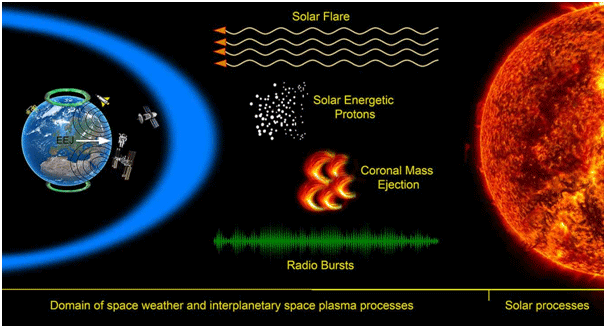Modelling Space Plasma processes In geospaCE (M-SPICE)
Chief Coordinator : Remya Bhanu & Members
Space weather is a term to describe the weather of the Sun-Earth system, which starts from describing the variations in the Sun and the solar wind and studies its impacts on the magnetosphere, ionosphere and thermosphere. Space weather can influence the performance and reliability of a wide variety of critical space-borne and ground-based technological systems.
Most space weather starts at the Sun. The coupled Sun-Earth space weather system consists of Sun, solar wind, solar magnetic field, terrestrial magnetic field, magnetosphere and ionosphere. When the sun is highly active, it generates high-energy solar energetic particles (SEPs) and considerably high energy radiation. The solar wind plasma speed and density increases substantially which manifests into Coronal Mass Ejections (CME), which when arrives at the Earth causes disturbances called as geomagnetic storms. During geomagnetic storms, the energy is transferred from the solar wind to the Earth’s magnetosphere-ionosphere-thermosphere system adding to the total energy budget of this complex integrated system. Electric currents in the system are enhanced during such space weather events which can have multi-fold impacts on critical space and ground infrastructures like disruption of electric power transmission lines leading to electricity blackouts, increased corrosion of the buried pipelines carrying gas and oil, disruptions in HF radio communications and satellite-based ground navigation, erroneous positioning and navigation information, drag of low Earth-orbiting satellites due to increased atmospheric density, reducing the lifespan of the low Earth-orbiting satellite, etc.

Extreme space weather events are quite rare. However, the satellite and communication systems are still impacted by moderate to weak space weather impacts due to the variability in the density and composition of the near-earth environment during these events. The intensity and impact of each space weather event is different and hence unique. Due to broad range of spatio-temporal scales involved in these phenomena, in-situ observations from satellites have limitations. This new research group at IIG is focused at understanding the crucial aspects of space weather phenomena and its impacts using modeling. While physics based modeling will be used to understand the physics and dynamics of the system during space weather events, huge data sets will also be utilized to model the system for a possible prediction of space weather events. The purpose of this scientific group is to ultimately develop space weather and impact prediction models for these low probable, but randomly occurring events.
Chief Coordinator : Remya Bhanu
Coordinator(s) : Bharati Kakad
Members : Remya Bhanu, Bharati Kakad and Tulasiram S., Research Students and Research Associates
{updated on 02-08-2024}